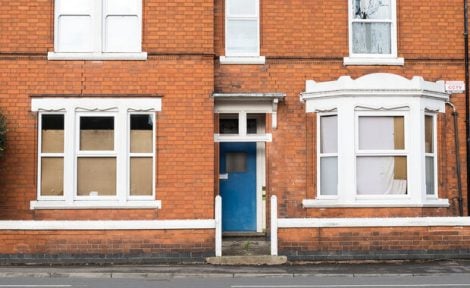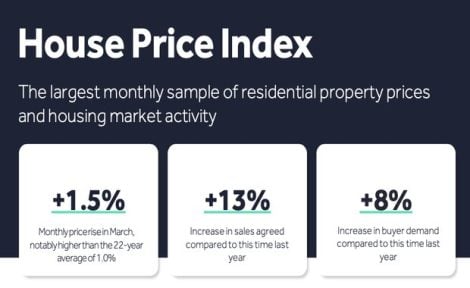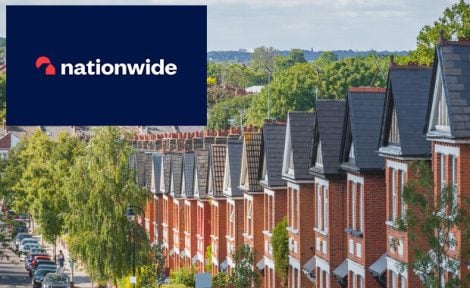Nationwide: House prices fall again as squeeze on mortgages hits
House prices fell again in January from August's high as growth is stalled by a lack of cheap mortgage deals.

House prices fell again in January leaving them considerably lower than their August high as growth was stalled by a lack of cheap mortgage deals.
Figures from Nationwide show annual house price growth slowed to 1.1% from 2.8% in December as cheaper mortgages firmly became a thing of the past.
January saw a further monthly price fall (-0.6%), which left prices 3.2% lower than their August peak.
RECOVER
And despite mortgage rates normalising, Robert Gardner, Nationwide’s Chief Economist, says it’s too early to tell whether activity in the housing market is starting to recover.

He says: “The fall in house purchase approvals in December reported by the Bank of England largely reflects the sharp decline in mortgage applications following the mini-Budget.
“It will be hard for the market to regain much momentum in the near term as economic headwinds are set to remain strong, with real earnings likely to fall further and the labour market widely projected to weaken as the economy shrinks.”
Gardner says that the biggest change in terms of housing affordability for potential buyers over the last year has been the rise in the cost of servicing the typical mortgage as a result of the increase in mortgage rates.
REDUCTIONS
He adds: “Should recent reductions in mortgage rates continue, this should help improve the affordability position for potential buyers, albeit modestly, as will solid rates of income growth, especially if combined with weak or negative house price growth.”
Gardner says that the overall affordability situation looks set to remain challenging and that saving for a deposit continues to remain a struggle as rents continue to rise.
All regions have seen a deterioration in affordability compared to 2021, with the cost of servicing the typical mortgage as a share of take-home pay now at or above the long-run average in all regions.
Wannabe buyers in London and the south of England are the worst hit when it comes to affordability while Scotland and the North continue to be the most affordable regions.
But even there, mortgage payments as a share of take-home pay are at their highest level for over a decade.
AFFORDABLE
Gardner adds: “There continues to be a significant gap between the least affordable and most affordable regions, although this has remained broadly stable over the last year. London continues to have the highest house price to earnings ratio at 9.2, but this is still below its record high of 10.2 in 2016.
“Scotland and the North region have the lowest house price to earnings ratios at 3.4. Over the longer term, Northern England and Scotland have historically seen lower HPERs than Southern England, Wales and Northern Ireland.”
The fizz has certainly left the market.”

Jeremy Leaf, north London estate agent and a former RICS residential chairman, says: “It was inevitable that house prices would continue slowing after such a strong run for most of last year but these respected numbers don’t tell the full story from the high street.
“They reflect activity at the end of last year when business was slowing quite rapidly after the mini-Budget shock but was still being supported by stock shortages.
“The fizz has certainly left the market, leaving behind more serious needs-driven as opposed to discretionary buyers, coming to terms with more stable mortgage rates and greater balance between supply and demand.
“Looking forward, the outlook for house prices remains fairly steady with no expectation of any dramatic change.”
This is more akin to the market tripping over its shoelace than falling off a cliff edge.”

Marc von Grundherr, Director of Benham and Reeves, says: “The decline in house prices seen in recent months is more akin to the market tripping over its shoelace than falling off a cliff edge and we’ve simply not seen the catastrophic property market decline that was so widely predicted during the latter stages of last year.
“Yes, buyers are treading with caution and sellers are having to adjust their price expectations in line with this changing market, but our appetite for homeownership remains strong and we continue to see activity despite wider economic turbulence.”
The current correction very much a return to market normality.”

James Forrester, Managing Director of Barrows and Forrester, adds: “Home sellers are continuing to secure a very good price in current market conditions and it’s important to remember that although house prices have started to cool, they remain there or thereabouts when compared to the meteoric highs of the pandemic market boom.
“So not only is the current correction very much a return to market normality, it’s fair to say that this return is taking far longer than predicted as the market continues to defy wider expectations against what are otherwise strong economic headwinds.”
The inevitable rebalancing of the market continues.”

Jason Tebb, OnTheMarket Chief Executive, says: “With annual house price growth continuing to slow in January and prices falling month-on-month, the inevitable rebalancing of the market continues as we head into a new year.
“All the upheaval – the macro-economic challenges and the chatter around fixed-rate mortgages, which although coming down are still higher than borrowers have grown used to – will inevitably impact the confidence of the average property-seeking consumer in the short term.
“That said, serious buyers and sellers continue to engage with each other despite rising interest rates and the cost of living.”
We can expect the herd mentality of the nation’s homebuyers to continue to dampen house price growth.”

Chris Hodgkinson, Managing Director of House Buyer Bureau, says: “While the market remains fairly strong, we can expect the herd mentality of the nation’s homebuyers to continue to dampen house price growth.
“During the pandemic boom, homebuyers were falling over themselves to offer above the odds to secure a home. This tide has very much turned and while there remains a robust level of market activity, we’re seeing a more reserved approach during the negotiation stage.
“As a result, the nation’s sellers are meeting in the middle and accepting a slightly lower price for their home, but this is very much a market correction rather than a slippery slope of house price depreciation.”
Volatility sparked by the the mini-Budget has largely dissipated.”

Mark Harris, chief executive of mortgage broker SPF Private Clients, says: “The swap rate volatility sparked by the the mini-Budget has largely dissipated and fixed-rate mortgage pricing continues to fall. Five-year fixes are now available for not much more than 4%, with Virgin Money launching a five-year fix of 4.17% this week.
“While the markets expect a 50 basis point rise in interest rates at February’s meeting, fixed-rate mortgages are set to continue to fall, while those on variable rates will see an uptick in their monthly repayments.”
There is an opportunity for professional investors to step in and re-capitalise the market.”

Avinav Nigam, cofounder of real estate investment platform, IMMO, says: “A key driver behind the slowing of house-price growth over the year to January is higher borrowing costs, since interest rates have risen in order to curb higher inflation.
“Higher borrowing costs are dampening demand, and therefore house price growth. From a price-income ratio, this might look like good news on the affordability of homes. However, it’s the opposite because at the same time, stress tests on mortgages are becoming harder to pass. The impact of this is disproportionately felt by typically younger and poorer people who are renting and aspire to home ownership.
“There is an opportunity for professional investors to step in and re-capitalise the market, including helping to improve the quality and energy performance of existing housing.”
Higher rates, coupled with higher inflation, is affecting affordability.”
Tomer Aboody, director of property lender MT Finance, says: “As mortgage rates have been climbing, we have seen a slowdown in the marker with both buyers and sellers waiting to see some stability.

“Higher rates, coupled with higher inflation, is affecting affordability and in turn either forcing buyers to be more patient or manage their purchase expectations.
“Some positive signs can be seen with swap rates reducing and therefore long-term upside in the market, especially if inflation can be halved as the Prime Minister has vowed to do.”




